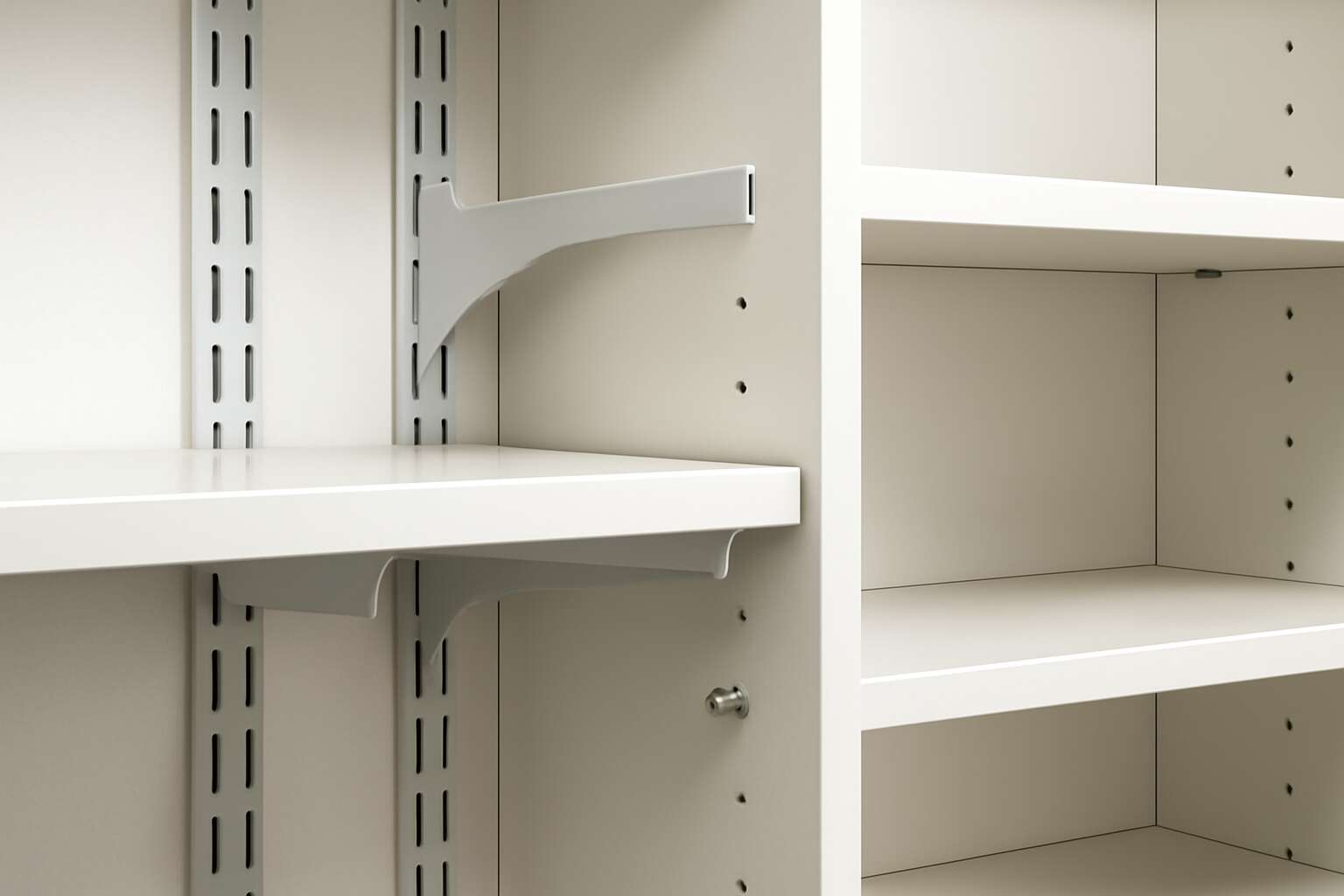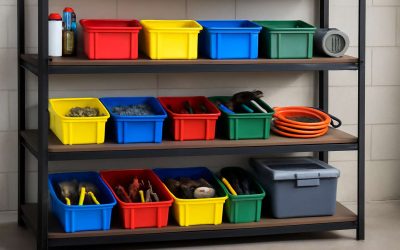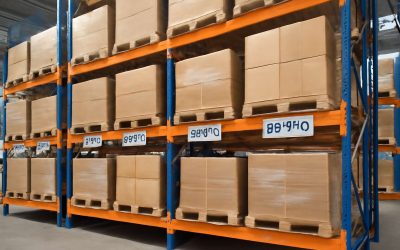Understanding Shelving Components
Types of Shelving Components – Overview of different types such as brackets, supports, rails, and panels
Understanding shelving components is crucial before designing or upgrading storage solutions. These components form the backbone of any sturdy shelving system, ensuring safety and functionality. From brackets to panels, each part plays a vital role in supporting loads and maintaining stability. In South Africa, choosing the right shelving components can mean the difference between a flimsy setup and a reliable structure that lasts for years.
There are various types of shelving components, each designed for specific applications. Brackets and supports are essential for holding shelves in place, especially under heavy loads. Rails provide additional reinforcement and help in adjusting shelf heights. Panels, often made from durable materials, serve as the surface that holds items and can be customized for different environments. When selecting shelving components, it’s important to consider weight capacity, material, and ease of assembly.
Here’s a quick overview of common shelving components:
- Brackets – support shelves and distribute weight evenly
- Supports – reinforce the structure, especially in heavy-duty shelving
- Rails – facilitate adjustable shelving heights
- Panels – create stable surfaces for storage
Materials Used in Shelving Components – Comparison of wood, metal, plastic, and composite options
Choosing the right materials for shelving components can transform a bleak storage space into a fortress of organization and durability. South African businesses and homeowners alike face the challenge of balancing strength with cost-efficiency — a decision that could mean the difference between a fleeting setup and a lasting solution. Materials such as wood, metal, plastic, and composite options each offer unique advantages that cater to diverse needs and environments.
Wood shelving components bring a natural warmth and aesthetic appeal, making them perfect for retail displays or office settings. Metal, on the other hand, is renowned for its robustness and capacity to support heavy loads, ideal for industrial warehouses or garages. Plastic components are lightweight and resistant to moisture, making them suitable for environments prone to humidity. Finally, composite materials blend strength and versatility, providing a durable yet flexible alternative for various shelving applications.
Understanding the nuances of these materials allows for better selection of shelving components that align with specific requirements. For example, metal shelving components are often preferred for heavy-duty storage, while plastic shelving components excel in humid or corrosive environments. Meanwhile, the choice of material influences not only the lifespan but also the safety and stability of the shelving system. When it comes to shelving components, material matters — and in South Africa, it could be the key to building something that truly lasts.
Common Materials for Shelving Systems – Durability, aesthetics, and best applications
In the realm of shelving components, understanding the intrinsic qualities of the materials used is paramount. Durability, aesthetics, and application specificity form the triad that guides discerning choices. South African businesses and homeowners often wrestle with the delicate balance between robustness and visual appeal—after all, shelving is more than mere storage; it’s an expression of space and purpose.
Materials such as wood lend a timeless elegance, their warm tones softening industrial environments or retail displays. Metal, with its unparalleled strength, supports heavy loads and endures the rigors of daily use, making it a staple in warehouses and garages. Plastic components, lightweight yet resistant to moisture, excel in humid settings, while composite materials fuse resilience with versatility, adapting seamlessly to diverse shelving needs.
When selecting shelving components, it’s essential to consider the environment and load requirements. For instance, shelving components crafted from metal are preferred for industrial applications, whereas plastic options shine in moist, corrosive conditions. The right material not only extends the lifespan of your shelving but also enhances safety and stability, transforming functional storage into a lasting asset.
Essential Shelving Components for Different Applications
Industrial Shelving Components – Heavy-duty supports, brackets, and fasteners for warehouse use
When it comes to industrial shelving, understanding the essential shelving components is crucial for creating a resilient and efficient storage system. Heavy-duty supports, brackets, and fasteners form the backbone of any warehouse shelving setup. These components are engineered to withstand the rigors of demanding environments, ensuring safety and stability even under substantial weight loads.
In high-capacity applications, selecting the right shelving components can mean the difference between a cluttered workspace and a highly organized, productive environment. For instance, industrial shelving components such as reinforced supports and corrosion-resistant fasteners are designed to endure harsh conditions, including humidity and heavy usage. This durability guarantees long-term performance, reducing downtime and maintenance costs.
Furthermore, tailored shelving components can be customised to suit specific needs, whether for storing heavy machinery parts or lightweight packaging materials. The versatility of these components allows for modular configurations, making future adjustments seamless. When choosing shelving components, prioritising quality and compatibility ensures your storage solutions remain robust and adaptable over time.
Residential Shelving Components – Stylish brackets, adjustable supports, and wall mounts
In the world of residential shelving, the right components can transform a simple space into a showcase of style and practicality. With homes evolving into multifunctional hubs, choosing the perfect shelving components becomes essential for both aesthetics and durability. Stylish brackets, adjustable supports, and sturdy wall mounts not only support your cherished possessions but also add a touch of sophistication to any room. These versatile shelving components allow for seamless customization, making it effortless to adapt your storage as needs change over time.
For those seeking a blend of function and flair, integrating components such as decorative brackets or concealed supports can elevate the overall look. Whether you’re creating a cozy book nook or a sleek kitchen display, selecting high-quality shelving components ensures stability and longevity. Remember—well-designed shelving components are the backbone of a clutter-free, inviting space that reflects your personal style and lifestyle. Discover how the right components can turn everyday storage into an artful statement—because in the end, every detail counts.
Office Shelving Components – Cable management, modular supports, and adjustable rails
In the fast-paced environment of modern offices, organization isn’t just a luxury—it’s a necessity. When it comes to shelving components for office shelving systems, precision and adaptability are paramount. Cable management solutions, such as specialized clips and conduits, ensure that wires stay hidden and tangle-free, preventing accidents and maintaining a sleek workspace. Modular supports and adjustable rails provide the flexibility to reconfigure shelving layouts effortlessly, accommodating evolving storage needs without costly replacements.
For optimal efficiency, some office shelving components include features like integrated cable channels or quick-adjust mechanisms. These innovations turn traditional shelving into dynamic systems that can grow with your business.
- Durable supports for heavy equipment
- Flexible rail systems for easy repositioning
- Concealed cable management for a tidy appearance
This combination of thoughtful design and robust materials ensures your shelving not only looks professional but also withstands daily wear and tear. When every detail matters, choosing the right shelving components makes all the difference—delivering stability, style, and seamless functionality in every workspace.”
Key Features to Consider When Choosing Shelving Components
Load Capacity – How to determine appropriate support based on weight requirements
When selecting shelving components, understanding load capacity is paramount to ensuring safety and longevity. The right support must match the weight of the items you plan to store, whether it’s delicate glassware or heavy-duty industrial equipment. Overestimating load capacity can lead to sagging or failure, while underestimating may result in unnecessary costs and complexity. It’s essential to consider the maximum weight each shelving component can support without compromising structural integrity.
In practical terms, this means assessing the combined weight of your belongings and choosing shelving components that can comfortably handle that load. For heavier applications, opt for industrial shelving components with reinforced supports and sturdy fasteners. Conversely, for lighter storage needs, residential or office shelving components with adjustable supports may suffice. Remember, the strength of the support directly influences the safety and durability of your entire shelving system.
To simplify your decision-making process, consider these factors:
- Material strength and quality
- The type of shelving support (fixed or adjustable)
- The distribution of weight across the shelf
Matching your shelving components to your load requirements ensures your storage solution remains reliable and secure, no matter the environment or application. In South Africa’s diverse settings, whether in bustling warehouses or stylish home interiors, understanding load capacity is the cornerstone of selecting the perfect shelving components.
Compatibility – Matching components with shelving systems and existing infrastructure
In the shadowy corridors of storage solutions, compatibility of shelving components is the unseen keystone that holds your entire system in balance. When selecting shelving components, it’s vital to ensure they seamlessly integrate with your existing shelving system and infrastructure. An ill-fitting component can turn your organized haven into a chaotic labyrinth, risking both safety and durability.
Understanding the compatibility of shelving components involves scrutinising the dimensions, fastening mechanisms, and material interfaces. For example, a support bracket designed for industrial shelving may be incompatible with residential units, leading to instability. To avoid such pitfalls, consider the following:
- Matching the mounting points and support styles
- Ensuring the materials complement each other for longevity
- Verifying the load capacity aligns with your storage demands
In South Africa’s diverse environments—whether in sprawling warehouses or elegant home interiors—the harmony between shelving components and their surroundings is paramount. Compatibility isn’t merely about fitting parts together; it’s about forging a resilient, enduring bond that withstands the test of time and weight. When the components align perfectly, your shelving system becomes a silent guardian of order, a testament to precision craftsmanship and thoughtful design.
Ease of Installation – Tools required, assembly time, and user-friendliness
In the quest for a seamless shelving system, ease of installation often goes unnoticed yet holds the key to long-term satisfaction. When selecting shelving components, understanding the tools required, assembly time, and overall user-friendliness can make all the difference between a smooth setup and frustrating delays. A well-designed shelving component should allow for straightforward assembly, even for those with minimal DIY experience. This not only saves time but also ensures safety and stability from the outset.
Consider shelving components that come with clear instructions and require minimal specialized tools—often, a simple screwdriver or wrench suffices. For larger projects, fasteners and brackets should be easy to align and secure, reducing the risk of misfit or instability. If you’re working within a tight timeline or limited space, choosing components that are quick to assemble can help maintain momentum. Ultimately, user-friendly shelving components empower you to create a resilient storage solution with confidence and efficiency.
Innovations and Trends in Shelving Components
Adjustable and Modular Systems – Flexibility for evolving storage needs
In the fast-paced world of storage solutions, innovation in shelving components has become a game-changer. Adjustable and modular systems are no longer just a trend—they’re the gold standard for flexibility in evolving storage needs. These systems allow users to reconfigure their shelving layout with a simple tweak here or a slide there, making them perfect for dynamic environments like South African warehouses or bustling offices.
One of the most exciting trends is the rise of intelligent shelving components that incorporate quick-lock mechanisms, reducing installation time and frustration. These innovations mean less downtime and more productivity, whether you’re outfitting a retail space or optimizing a home garage. The beauty lies in their ability to seamlessly adapt, ensuring your storage infrastructure keeps pace with your changing requirements.
- Enhanced load capacity for heavier items
- Compatibility with a wide range of existing infrastructure
- Ease of assembly with minimal tools required
By embracing these cutting-edge shelving components, businesses and homeowners alike can enjoy a tailored storage experience—one that evolves as quickly as their needs do. After all, in a world that never stands still, why should your shelving do any less?
Eco-Friendly Materials – Sustainable options and environmentally conscious manufacturing
In a world increasingly conscious of our ecological footprint, the evolution of shelving components reflects a profound shift towards sustainability. Eco-friendly materials are no longer an optional luxury but an essential criterion for responsible manufacturing. Manufacturers now harness renewable resources, recycled plastics, and biodegradable composites to craft shelving components that serve both function and conscience. This marriage of durability and sustainability ensures that your storage solutions are aligned with environmental imperatives, fostering a sense of moral integrity in every choice.
Innovative trends also include the integration of environmentally conscious manufacturing processes that minimize waste and energy consumption. For instance, sourcing raw materials locally reduces carbon emissions and supports regional economies—an important consideration for South African businesses eager to balance growth with ecological stewardship.
As the demand for greener options grows, so does the array of sustainable shelving components available. From lightweight, recyclable plastics to reclaimed wood supports, these options enhance the aesthetic appeal of residential and commercial spaces. Choosing eco-friendly shelving components isn’t just a nod to the planet; it’s an affirmation of a conscious lifestyle, echoing the deeper human desire to preserve what remains of our fragile environment.
Aesthetic Design and Customization – Modern finishes, colors, and personalized solutions
In the ever-evolving landscape of interior design and functional architecture, innovation in shelving components is a testament to human ingenuity and aesthetic pursuit. Modern finishes and vibrant colors are transforming mundane storage solutions into striking focal points, elevating both residential and commercial spaces. The contemporary emphasis on personalized solutions means that shelving components are no longer standardized; instead, they are tailored to reflect individual taste and unique spatial demands.
Aesthetic design now incorporates sleek, minimalist profiles or bold, statement-making textures. For those seeking a bespoke touch, custom shelving components offer unparalleled flexibility—allowing for integration of curved lines, mixed materials, or artisanal craftsmanship that resonates with a space’s character. It’s about more than just utility; it’s about creating an environment that feels authentic and alive.
Innovative trends also include the advent of modular systems, which provide effortless adaptability. This approach supports evolving storage needs and encourages creative expression. Whether through layering different finishes or blending unconventional hues, the possibilities with shelving components are virtually limitless. The pursuit of beauty and function in shelving design is an ongoing dialogue—a reflection of human desire to craft spaces that inspire and endure.
Maintenance and Safety Tips for Shelving Components
Regular Inspection and Repairs – Ensuring longevity and stability
In the intricate dance of organization, shelving components stand as silent sentinels—guardians of order that demand vigilant oversight. An astonishing 70% of shelving failures stem from overlooked maintenance, underscoring the vital importance of regular inspections and timely repairs. When neglected, even the sturdiest shelving components can become liabilities, risking collapse and endangering valuable inventory or personnel safety.
To safeguard longevity and stability, implementing a routine inspection schedule is paramount. Look for signs of wear such as rust, loose fasteners, or warping—each a precursor to potential failure. Addressing these issues promptly with repairs, whether tightening bolts or replacing compromised parts, preserves structural integrity. Remember, the integrity of shelving components not only depends on their initial quality but also on ongoing care. An overlooked cracked support or bent bracket can silently compromise the entire system, turning a minor issue into a costly disaster.
In environments where shelving components bear substantial weight, the use of safety clips and reinforcement brackets can dramatically enhance stability. Incorporating these small, often overlooked elements into your maintenance routine ensures your shelving system remains resilient against the unpredictable stresses of daily use. Ultimately, meticulous inspection coupled with swift repairs sustains the foundational safety of your storage solutions, transforming ordinary shelving into an enduring asset.
Proper Installation Techniques – Preventative measures to avoid accidents
Proper installation of shelving components isn’t just about aesthetics—it’s a crucial safety measure that prevents catastrophic failures. A slip-up during setup can turn a sturdy storage system into a dangerous hazard in seconds. Ensuring each component is correctly positioned and securely fastened forms the backbone of a resilient shelving system.
Begin by carefully selecting the right tools—wrenches, screwdrivers, and levelers—to guarantee precision. Double-check weight ratings and compatibility with your existing infrastructure. When installing, follow manufacturer guidelines meticulously. For added stability, consider incorporating reinforcement brackets and safety clips, especially in high-traffic or heavy-load environments.
To prevent accidents, always verify that all fasteners are tight and that supports are evenly aligned. Regularly inspect the integrity of the shelving components—look for signs of wear or misalignment. Remember, a well-installed shelving system is a silent guardian, safeguarding your inventory and personnel from unforeseen collapses. Vigilance in installation and ongoing maintenance transforms ordinary shelving into an unbreakable fortress of order and safety.
Cleaning and Upkeep – Materials compatible with different cleaning methods
Maintaining shelving components isn’t just about keeping things neat; it’s a matter of safety and longevity. Neglecting cleaning and upkeep can turn a seemingly dependable system into a ticking time bomb—especially in bustling warehouses or busy offices. Regular inspection and gentle cleaning prolong the life of shelving components and prevent unexpected collapses that could harm personnel or damage valuable inventory.
Choose cleaning materials that are compatible with the specific shelving components you have. Metal supports respond well to mild detergents and soft cloths, while plastic panels might require gentle, non-abrasive cleaners. For wooden shelving components, avoid overly moist cleaning agents to prevent warping or rot. It’s a good idea to keep a list of compatible cleaning materials handy, especially if your shelving system incorporates a mix of different materials—this prevents accidental damage.
- Use non-corrosive cleaners for metal supports and fasteners
- Avoid harsh chemicals that can degrade plastic or wood
- Regularly wipe down to prevent dust buildup, which can compromise weight capacity over time
Remember, a little bit of routine maintenance goes a long way in ensuring your shelving components remain as reliable as when they were first installed. Regular inspections to spot signs of wear, corrosion, or misalignment help catch potential issues early—because nobody wants their neatly organized warehouse to turn into a chaos zone overnight!




0 Comments